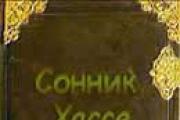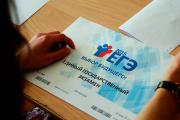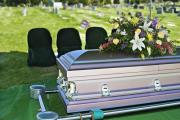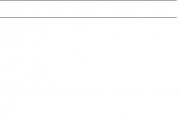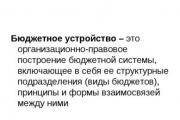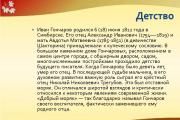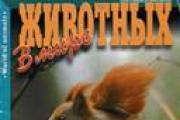Depreciation period 1c accounting. How to change the parameters for calculating depreciation of fixed assets. According to uniform depreciation rates
In this article, as a continuation of the previous one, we will look at other documents in which depreciation parameters are established or changed.
1. Changing the parameters for calculating Depreciation;
This document establishes new depreciation parameters for management and accounting. You can set the checkbox to use new parameters already in the current month (Fig. 1).
2. Changes in fixed assets depreciation schedules;
Here you can set a new depreciation schedule, select the schedule from the pop-up directory, and if necessary, create a new fixed asset depreciation schedule (Fig. 2).

3. Changes in the methods of reflecting expenses for depreciation of fixed assets;
This document establishes a new Method of reflecting depreciation expenses (Fig. 3) (We also establish the “Method of reflecting depreciation expenses” in the documents “Accepting fixed assets for accounting” and “Entering initial balances for fixed assets”;

4. Changes in OS state;
This document states (Fig. 4):
- the “bird” affects depreciation charges;
Calculate depreciation;
Calculate depreciation in the current month.

If all depreciation parameters are set correctly, then the depreciation document will calculate depreciation. If somewhere in the accounting for fixed assets an error was made regarding depreciation, then in order to obtain depreciation it must be corrected.
Now let's look at the document Depreciation of fixed assets (Fig. 5).
Documents - Fixed assets - Depreciation of fixed assets

The document itself is simple, we set the depreciation date, the name of the organization, and calculate Depreciation according to management and accounting. From the document Depreciation of fixed assets, you can go to a number of documents structurally related to the calculation of Depreciation (via the Go menu item):
Journal of postings (accounting) - shows the correspondence of fixed assets depreciation accounts with cost accounts for this Depreciation document;
Expenses;
Costs (accounting);
Costs for the construction of OS facilities;
Cost of fixed assets (accounting) - displays a list of fixed assets in the list and the amount of accrued depreciation for each, can be printed;
Construction of fixed assets (management accounting);
Cost accounting (for managerial, accounting and tax accounting) shows for each fixed asset the type of cost (Fig. 6);
Cost accounting (accounting) - in Fig. shows a cost accounting table

Based on the depreciation of fixed assets, you can generate a Statement of Depreciation of fixed assets for the period (Fig. 7)
Reports - Fixed assets - Fixed assets depreciation statement

The depreciation sheet is generated according to management, accounting or tax accounting data; using the settings, you can set selection criteria (for example, make a report for a specific group of fixed assets or for the division to which the fixed assets belong). We will talk about these reports in more detail in the next topic, “Working with OS reports.”
Vladimir Ilyukov
The existing methods of calculating depreciation have been supplemented with one more. This is the so-called lump sum method of charging depreciation of fixed assets. The basis for its implementation was the order of the Ministry of Finance of the Russian Federation dated May 16, 2016 No. 64n. This legislative act added the method of one-time depreciation of fixed assets, paragraph 10, paragraph 19 of PBU 6/01 “Accounting for fixed assets”. The new depreciation method became available to users starting from version 3.0.43.253.
Legal entities that have the right to use simplified methods of accounting and financial accounting are granted the right to charge depreciation on industrial and business inventory in the amount of 100% of book value at a time, that is, one-time.
The new method has a very important feature. A one-time depreciation charge is carried out at the time of acceptance of the fixed asset for accounting . In addition, it has two limitations.
- Only those persons who legally maintain simplified accounting (financial) records have the right to carry out one-time depreciation.
- These organizations have the right to charge one-time depreciation only for those fixed assets that in the OKOF belong to the section “Industrial and business inventory.”
The right to use simplified methods of accounting and accounting (financial) reporting in accordance with Part 4 of Article 6 of the Federal Law of December 6, 2011 No. 402-FZ was granted
- small businesses;
- non-profit organizations and
- organization that has received the status of a participant in the Skolkovo project.
You cannot limit yourself to this list, because Part 5 of Article 6 of the Federal Law of December 6, 2011 No. 402-FZ clearly lists legal entities that do not have the right to use simplified accounting methods. For example, housing cooperatives do not have this right.
Order No. 64n simplified not only the calculation of depreciation of fixed assets. He expanded the range of simplified accounting methods in other aspects. An extensive commentary on simplified accounting methods is published here http://buh.ru/articles/documents/48157. Essentially, this order is another step towards simplifying accounting.
In order to calculate depreciation on a fixed asset at a time in the 1C Accounting 8.3 program, you need to select the value “One-time upon acceptance for accounting” in the “Acceptance for accounting of fixed assets” registrar, on the “Accounting” tab, in the “Method of calculating depreciation” list. This is the new method of calculating depreciation added in 1C 8.3. Let's consider this method of calculating depreciation of fixed assets in 1C 8.3 for organizations and entrepreneurs using the simplified tax system.
Organization LLC “Simplified commissioning. OS”, using the simplified tax system-15%, purchased an office sofa for the director’s reception area on January 2, 2017 for RUB 70,800, incl. VAT 10,800 rub. Payment for the sofa was also made on the same date. The sofa was put into operation on February 15, 2017. When accepting a sofa for accounting, it is necessary to charge depreciation at a time in 1C 8.3 for the entire amount of its book value.
In the 1C Accounting 3.0 configuration, registration of purchased operating systems is reflected by the “Equipment Receipt” registrar. In accounting, he creates an entry in the debit of account 08.04.1 “Purchase of components of fixed assets” from the credit of account 60.01 “Settlements with suppliers and contractors”.
![]()
Since Simplified Commissioning LLC. OS" applies a special regime of the simplified tax system, then the amount of VAT is written off to increase the initial cost of the sofa. As a result, it became equal to 70,800 rubles.
Acceptance of fixed assets for accounting of fixed assets is reflected by the registrar “Acceptance for accounting of fixed assets.” In it, on the “Accounting” tab, we will assign the “Method of depreciation calculation” variable to the value “One-time upon acceptance for accounting.”

One-time depreciation of fixed assets in 1C 8.3 is applied only to production and business equipment . This is a legal norm. In the information base it is taken into account as follows. When describing fixed assets in the “Fixed Assets” directory, on the “Main” tab in the “Fixed assets accounting group” field, you must assign the value “Industrial and business inventory.”
Go to the “Tax accounting (USN)” tab. Taxpayers using the simplified tax system have the right to include in fixed assets only those that are recognized as depreciable property. This is recognized as property whose book value exceeds 100,000 rubles and whose useful life exceeds 12 months.
In the example considered, the sofa does not fit into the category of depreciable property, because its original cost is less than 100,000 rubles. Because of this, the attribute “Procedure for including costs as expenses” must be assigned the value “Include as expenses.”

In this context, the phrase “Include in expenses” is equivalent to the phrase “Include in material expenses.” The procedure for recognizing material expenses is established in the accounting policy. For the organization of Simplified Commissioning LLC. OS" the following order is established. Material expenses are recognized in the reporting (tax) period in which two conditions are met in the information period: the fact of receipt of the sofa and the fact of its payment are registered.
It is not enough to enter a payment document in the information base. Even if it is entered on the basis of the “Receipt of equipment” registrar, it still It is necessary to indicate the date and amount of payment for the OS on the “Tax Accounting (STS)” tab. This will allow the registrar “Acceptance for accounting of fixed assets” to create an entry in the accumulation register “Registered payments of fixed assets (STS)”. Without this record, the system will not allow you to take into account the costs of purchasing a sofa.
The “Acceptance for accounting of fixed assets” registrar creates records in a variety of fixed assets accounting registers, including the accounting register “Journal of transactions (accounting and tax accounting)”. In it, the registrar created two records.

The first entry reflects the fact of converting a purchased non-current object (office sofa) into an OS object. Entry number 2 reflects the calculation of depreciation in 1C 8.3 for the amount of the book value of the sofa. As a result, the residual value of the sofa becomes zero. At the same time, the sofa remains on the balance sheet and continues to be used.
By standard methods, depreciation is calculated over the useful life of the asset. For example, depreciation is calculated using the straight-line method on a monthly basis, starting from the month following the month in which the fixed asset was accepted for accounting.
The considered example shows that depreciation is accrued on 100% of the book value of the sofa and it is accrued on the date of acceptance of the fixed assets for accounting, on February 15, 2017.
Perhaps someone will have a question, why was depreciation calculated on 02/15/2017, and not on 01/22/2017? The answer is simple - this is a legal requirement, paragraph 10, paragraph 19 of PBU 6/01. It established that one-time depreciation is accrued at the moment the asset is accepted for accounting .
In fact, the registrar “Receipt of equipment” dated January 22, 2017 entered into accounting, in the debit of account 08.04.1 “Purchase of components of fixed assets”, a certain non-current asset was accepted. This is not yet the main tool. In the standard scheme, the initial cost of the operating system is formed on account 08.04.1. After it is formed, the asset is accepted for accounting, but as a fixed asset by the registrar “Acceptance for accounting of fixed assets”.
In general, in the 1C Accounting program, registration of an operating system takes place in three stages: Receipt of an asset - Formation of the initial cost - Acceptance of fixed assets for accounting. If a fixed asset is accepted for accounting at an initial cost equal to the cost of the supplier, then the delivery for accounting takes place in two stages: Receipt of an asset - Acceptance of fixed assets for accounting.
Starting with version 3.0.46.11 in the 1C Accounting 8.3 configuration, an even simpler way to accept OS for accounting has appeared. Now, when capitalizing a fixed asset, you can immediately take it into account. That is, a one-step scheme for registering OS has been implemented. A separate article will be devoted to this issue..
The fact that material expenses are taken into account in tax accounting according to the simplified tax system is clearly demonstrated by the KUDiR report.

Despite the fact that depreciation on the OS in 1C 8.3 was calculated at 100% of the book value of the sofa, it remains on the balance sheet at its original cost. It will remain on the balance sheet until it is removed from the balance sheet. For example, an offended visitor tore up a sofa so much that it cannot be restored. To reflect the disposal of the sofa from the balance sheet, we will create a “Write-off of fixed assets” registrar. It will generate two entries, the second of which the sofa is written off the balance sheet.

Sometimes the question arises: can a given OS object be classified as industrial or business equipment? There's no point in guessing. You just need to turn to the All-Russian Classifier of Fixed Assets (OKOF). It contains a number of sections, among them there is a section “Industrial and household inventory”. It also contains the definitions we need.
- Industrial equipment is objects for technical purposes. They are used in the production process, but do not belong to equipment or structures. For example, special furniture, body armor, training equipment, containers, etc.
- Household equipment is objects for office and household purposes. They are not directly used in the production process. For example, office furniture, watches, carpets, etc.
These definitions do not provide a clear distinction between production equipment and household equipment. For example, one safe is installed in the accounting department for especially valuable documents, and another exactly the same one can be installed in the workshop for storing personal tools. In the first case, the safe is a household item, and in the second case, it is a production item.
Fortunately, there is no particular need to clearly distinguish between these types of equipment. Both production and household equipment are included in one general group called “Industrial and household inventory”.
You can load the OKOF classifier into the 1C Accounting 8.3 program. This allows you to quickly resolve the issue of whether an OS object belongs to production and business equipment.

This article discusses only one element of simplified accounting. In fact, Order No. 64 contains several similar accounting elements. And here I would like to emphasize that even if a legal entity or entrepreneur has the right to use simplified methods of accounting and financial accounting, they must consolidate them in their accounting policies.
HOW TO CALCULATE DEPRECIATION IN 1C
Although in the accounting community, calculating depreciation is considered a very lengthy and complex process, if you take a look, you will be pleasantly surprised at how simple it is. By the way, this process was successfully automated in earlier versions. The accountant is only responsible for carefully filling out the source documents and verifying the results obtained.
Traditionally depreciation of fixed assets and fixed assets are produced at the end of the month during the month-end closing process. Sometimes at the beginning of the implementation of 1C in an enterprise, accountants practice entering fixed assets using a document "OS commissioning". This allows you to save time on data entry during the initial implementation of the program. The disadvantage of this practice is that until the end of the service life of such objects it will be necessary to fill out the depreciation value by manually adjusting document entries, field “Cost for calculating depreciation” on the tab “Asset depreciation parameters (accounting)”
Figure 1: Manual cost adjustment to calculate depreciation in the OS Commissioning document.
In the document “Changing depreciation parameters” On the OS tab, the main parameters for calculating are set; at the bottom of the tab there are reference books and documents that allow you to fine-tune display methods, tax assignments and many other parameters for calculating depreciation.
Figure 2: Directories and documents for managing the parameters for calculating depreciation of fixed assets.

Even if you are faced with a question for the first time how to calculate depreciation in 1C 8.2, clear names and a convenient interface with tips will help you solve it quickly.
Next you should enter the document "Closing of the month", which can be called from the same bookmark, or from the main menu Operations->routine operations->Month closure. In the new document, leave the checkboxes in the item "Depreciation calculation", if there is no need to perform other actions at the moment.
Figure 3: Calculation of depreciation using the “Month Closing” document.

Click the OK button at the bottom of the window, the charges are ready. The document will do everything itself. If error messages appear during the execution process, you should write down this document without execution, correct the original documents and repeat the execution of our document "Closing of the month".
Figure 4: Postings for depreciation of fixed assets.

Now you know, how to calculate depreciation in 1C 8.2 and could see that the system can significantly facilitate this process. All that remains is to make sure that the amounts and transactions in the accounts are correct.
- Depreciation group. The size of the depreciation bonus, which will subsequently be included in the cost of goods, products, and services, depends on the correct completion of this detail.
The ENAOF code was used until January 1, 2002 and filling it out is not necessary if the facility was put into operation after this period.
After filling out the Main tab in the directory, go to the BU Information tab. The menu item Enter Acceptance Document for Accounting opens. Click on the document and create a new one:

Let's fill in all the document tabs sequentially.
The Non-current asset tab, where we indicate the specified parameters and necessarily account BU 08.04, if fixed assets were purchased for a fee, or other subaccounts of account 08, in accordance with the method of receipt of the object:

On the Fixed Assets tab, use the Add button to add a fixed asset from the directory:

Then, on the Accounting tab, fill in the required details:
- Accounting account – 01;
- Accounting procedure – depreciation calculation;
- The depreciation account is 02.01, and put a tick in the “Calculate depreciation” box. If this mark is not present, then depreciation will not be accrued;
- The method of calculating depreciation is linear, according to the example;
- Useful life - indicated in months, based on the number of years of use of the OS:

The method of reflecting depreciation expenses is depreciation; this subconto specifies a cost item. You can specify any cost account. When posting a document, depreciation entries in accounting are formed based on the specified method:

In a similar way, fill in the information on the Tax Accounting tab. If we do not want to calculate depreciation in tax accounting, then we do not need to check the Accrue depreciation checkbox:

In our example, depreciation is not calculated in tax accounting. After filling out all the data, we run the document and receive transactions that we can view by clicking on the DtKt icon:

How to set depreciation parameters for accounting and tax accounting in 1C, see our video lesson:
Calculation of depreciation in 1C 8.3 - step-by-step instructions
The next stage of work is the calculation of depreciation. To do this, in 1C 8.3 you need to create a Scheduled Operation document:

Select the type of operation: Depreciation and wear and tear of fixed assets:

Click the Create button, select the period in the window that opens and run the Execute and Close document:

The operation will be carried out and displayed in the list of routine operations:

We can see information about document posting in the postings to the document:

Or in printed form of the Calculation Help document, which is located on the Routine Operations tab:

You can also generate a Calculation Certificate in the Month Closing document, where you can also perform the Depreciation operation:

On the website you can view the configuration of 1C Accounting 8.3. Or you can on the topic of the article.
Please rate this article:
Not so long ago, following changes in legislation, changes occurred in 1C: Public Institution Accounting 8 rev.1.0, and several documents intended for adjusting depreciation parameters ceased to be used. What documents now need to be used instead of outdated ones?
So, the document “Changing depreciation parameters” is outdated (Fig. 1), and now the necessary information is entered in different documents, it all depends on its type.
In order to change the procedure for paying off the cost, as well as the method of calculating depreciation and the useful life, the document “Changing the cost, depreciation of fixed assets and intangible assets” is used. The document contains several types of operations (Fig. 2).

Let's consider the first operation. A situation often arises when, for various reasons (an error in accepting a fixed asset for accounting, identifying errors during an inventory), it is determined that the useful life of a fixed asset is indicated incorrectly. The operation “Change depreciation (106, 109, 401.20 - 104)” allows you to adjust the useful life, as well as the amount of depreciation that changed when correcting OKOF. To correctly reflect transactions and generate primary accounting documents, it is necessary to take into account the following points (Fig. 3):
- Operation - Change of depreciation (106, 109, 401.20 - 104) specifies the details of the tabular part of the Fixed Assets tab.
- Primary document (Document type, Number, from) - data of the base document.
- KFO, NFA type - parameters for selecting objects in the tabular part of the document.
- In the Selection by hyperlink field, you can set additional conditions for selecting objects.
- Type of movement of non-financial assets - the value necessary to reflect the turnover of changes in the amount of depreciation in the form of regulated reporting 0503768 “Information on the movement of non-financial assets”. We recommend specifying the value Other change.
On the Fixed Assets tab, you should select fixed assets objects into the table (buttons, Selection or Fill in), the useful life of which you want to clarify.
- The object data will be indicated in substrings before the change: and after the change:.
- In the subline after the change: you should set the correct Useful Life and the Amount of Depreciation that should be accrued for the period in which the incorrect calculation was made.

In the example, the period and amount of depreciation have been changed. The transactions generated by the document are presented in Fig. 4

The new useful life, remaining useful life and residual value of the fixed asset as of the date of the document “Change in value, depreciation of fixed assets and intangible assets” are recorded in the information register “Calculation of depreciation of fixed assets” for further calculation of depreciation under the changed conditions (Fig. 5).

Changes in the useful life and calculation of depreciation of fixed assets will be reflected in the inventory card (Fig. 6), which can be printed:
- from the mode of viewing a directory element Fixed assets, intangible assets, legal acts;
- using processing Group printing of inventory cards (OS, intangible assets, legal acts - Reports on OS, intangible assets, legal documents).

Starting from the month of detection and correction of an error in accounting data, depreciation will be calculated according to the new specified parameters (Fig. 7).

The following operation “Change in value (101, 102 - 106, 401.10), depreciation (106, 109, 401.20 - 104)” (Fig. 8) is used to charge additional depreciation up to 100% of the book value for fixed assets (intangible assets), for which the method depreciation calculation was changed to “100% upon commissioning”.
In the document, we must indicate the CFO (financial security code) on which the fixed asset is taken into account.
In the tabular section, you can change the useful life, the order of repayment of the cost, the method of calculating depreciation, the book value and the amount of depreciation.

The operation “Change in value (401.10 - 101, 102), depreciation (104 - 101, 102)” (Fig. 9) is used to reflect the liquidation of part of an asset (intangible asset).
We fill out the income account to which the amount from the liquidation will be allocated. We change the book value and then click the “Recalculate depreciation” button.

This document generates transactions for the debit of account 401.10 and the credit of account 101.36.
And one more operation in the document “Change in value (401.20 - 101, 102), depreciation (104 - 401.20)” (Fig. 10) is used to change the useful life of fixed assets with a linear depreciation method.
In the account details we set the expense account 401.20 and indicate the new useful life. If you need to change the amount of accrued depreciation, according to the new period, then click the “Recalculate depreciation” button.
To suspend and resume the calculation of depreciation, use the document “Suspending the calculation of depreciation.”

The document contains several operations: “Suspend depreciation”, “Resume depreciation”, “Preservation” and “Re-preservation” (Fig. 11). We choose the one we need.

We select the fixed asset in the tabular section and post the document.
The details “OKOF code” and “Depreciation group” can be changed in the directory “Fixed assets, intangible assets, legal acts”.
We go to the fixed asset card and change the details (Fig. 12).

The correctness of the operations performed can be checked by generating a standard “Depreciation Statement” report.
The article was prepared using materials from the 1C:ITS website

